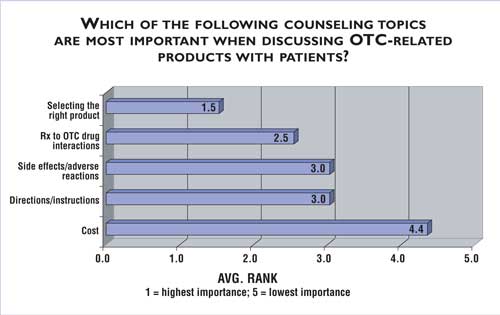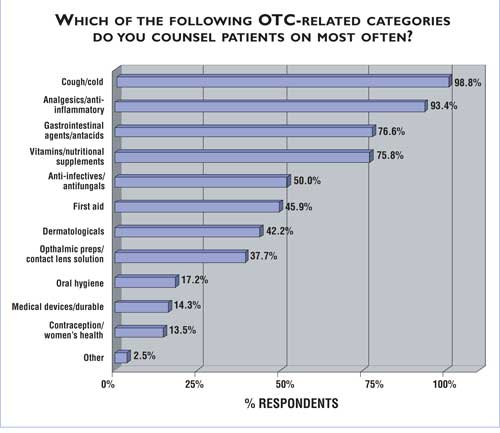US Pharm. 2007;32(7)(OTC suppl):4-6.
Community pharmacists can influence how OTC
medications should be used and, in many instances, which products are
actually purchased by patients. According to the U.S. Pharmacist 2007
OTC Survey, more than half (58.1%) of the pharmacists polled reported that
they "very often" field questions from patients that are specifically related
to OTC products, and an overwhelming majority (94.7%) said they have an active
role in counseling patients about OTC medications. What does this mean for
patients and the companies that manufacture OTC products? For patients, it
means better control over their ability to self-medicate; for manufacturers,
pharmacists' consultations usually translate into a sale of their product.
Since pharmacists are
consistently ranked as one of the most trusted health care professionals, it
should come as no surprise that consumers often turn to them for information
about OTC products.
The Self-Medication Trend
Because
self-medication is a growing trend, pharmacist consultations and
recommendations of OTC products have an important role in health care.
According to a 2006 survey by Roper Starch Worldwide, almost 60% of Americans
are more likely to treat themselves than they were the year before. In fact,
73% said they would rather treat themselves than see a physician. In addition,
62% of respondents said they would self-medicate in the future, and 96% said
they were generally confident about the health care decisions they make.
Manufacturers of OTC products
have accommodated this growing trend by launching new and innovative OTC
products and by adding to product lines of proven favorites. According to
Nielsen data, this has propelled OTC sales to a more than $15.4 billion
business. Increased OTC sales and the desire to self-medicate have been fueled
by many factors, including rising medical costs, limited physician office
hours, convenient pharmacy locations, availability of pharmacists to answer
consumers' questions, and the plethora of products that have switched from
prescription to OTC status over the years.
The Consumer Healthcare
Products Association reported that since 1975, there have been nearly 100
products switched from prescription to OTC status. Generally, prescription
medications are switched to OTC status once they have been on the market for
some time and have proven to have a wide margin of safety and efficacy.
However, products that were once prescription tend to be more potent than
their nonprescription predecessors in their respective therapeutic categories
and might potentially produce more serious side effects that require
pharmacist intervention.
Survey Demographics
The majority of
pharmacists who responded to the U.S. Pharmacistsurvey were from chain
pharmacies (41.4%) and independent retail pharmacies (34.4%). Other
respondents included pharmacists working at supermarket pharmacies, discount
store pharmacies, and health systems and managed care facilities.
More than three-quarters
(80.6%) of the respondents classified themselves as a staff pharmacist; 9.7%
said they were a chief pharmacist, a director of pharmacy, or a supervisor.
The remaining categories consisted of a combination of consultant pharmacists
and those working in academia.
When asked what approximate
percentage of their pharmacy business comprised OTC product sales, 43.7%
responded between 11% and 25%, and 37.6% said between 1% and 10%; the
remaining 18.8% said that 26% or more of their business was related to OTC
sales.
Pharmacist Consultation
Because of their
availability and close proximity to patients who purchase OTC medications,
retail community pharmacists are in the best position to counsel patients on
the choice and use of OTC medications and related health care products. The
U.S. Pharmacist survey confirmed that many pharmacists are already
providing this valuable professional service. More than 90% said they take an
active role in counseling patients on OTC-related products. According to
respondents,
selecting the appropriate product is the biggest concern for most patients. Other important
counseling topics included
prescription-to-OTC drug interactions, side effects, adverse reactions, and instructions
on how to take the medication. Cost was lower on the list of important issues.
When discussing drug
interactions, patients primarily asked whether or not the product could be
taken with other drugs. Other questions concerning drug interactions included:
• What are the signs of
a drug interaction?
• What foods/beverages
should be avoided?
• How does the product
work?
• Is there additional
information available about the product or medical condition?
The survey revealed that 41.6%
of the pharmacists make recommendations for six to 10 OTC products per day.
When asked which products pharmacists counseled patients on most frequently,
98.8% answered cough and cold products, followed closely by
analgesics/anti-inflammatory drugs (93.4%) and gastrointestinal
agents/antacids (76.6%), and vitamins/nutritional supplements (75.8%). Other
products that pharmacists commonly counseled patients on included anti-infec
tives/antifungal agents (50.0%), dermatologic medications (42.2%), first aid
(45.9%), ophthalmic products including con tact lens solutions (37.7%), oral
hygiene (17.2%), medical devices and durable medical equipment (14.3%),
contraception and other women's health products (13.5%), and other product
categories (2.5%), including laxatives and anti-smoking products.

Where Pharmacists Get Their Information
When pharmacists
were asked about which educational tools they need to initiate consultative
services with patients who are thinking of purchasing an OTC product, their
response was split between patient education materials and product information
guides. More pharmacists believed that pharmaceutical companies are not
providing them with enough information to carry out their consultative
services--45.2% answered "yes," while 54.8% answered "no."
More than three-quarters
(86.9%) of all the pharmacists said they garner OTC-specific product
information from articles written in professional journals and supplements.
Other useful resources they cited were the Internet (29.9%), product-specific
mail from pharmaceutical companies (35.7%), pharmacy association conferences
(16.4%), multiple product information from independent direct mail companies
(20.5%), and "other sources," including continuing education courses, product
labels, information learned in pharmacy school, personal experience, and
pharmacy review books.
The survey also explored what
types of information pharmacists would like to receive. The five most
important pieces of information were, in descending order, potential
interactions of OTC products with prescribed therapy, treatment of diseases or
conditions with OTC therapy, concurrent use of OTC products with prescribed
therapy, prevention of diseases or conditions with OTC therapy, and a focus on
specific OTC products and/or categories.

Conclusion
The results of the
U.S. Pharmacist 2007 OTC Survey uncovers the key role that pharmacist
counseling has in ensuring that patients are adequately educated about the OTC
products they purchase. Because of the pharmacist's availability to patients,
they are often asked questions concerning OTC products, their side effects,
and the differences between one OTC product and another. Pharmacists also have
an important role is consulting with patients about possible drug–drug
intereactions with the presciption drugs they are taking. In some instances a
patient may be taking the same ingredient they have already been prescribed,
and in other cases, the OTCmay interact with their prescription medication.
The pharmacist is in the best position to recommend one product over another
based on their discussions with the patient.
With more potent
prescription-to-OTC medications making their way to pharmacy shelves, it is
important that pharmacists receive up-to-date information about these products
in order to help patients make informative decisions about their OTC purchases.
To comment on this
article, contact editor@uspharmacist.com.






